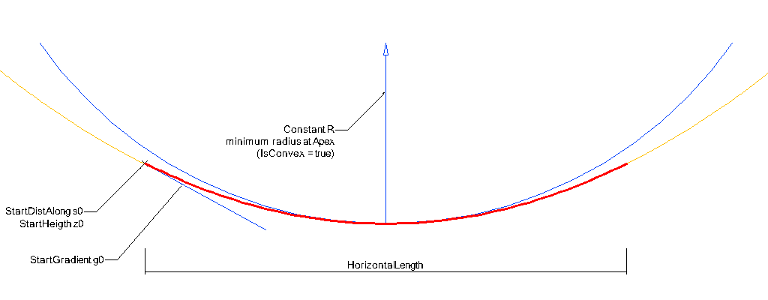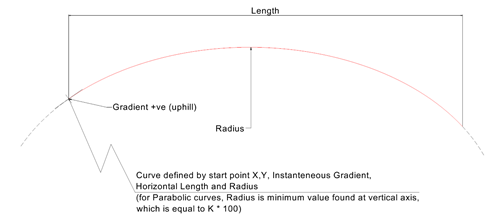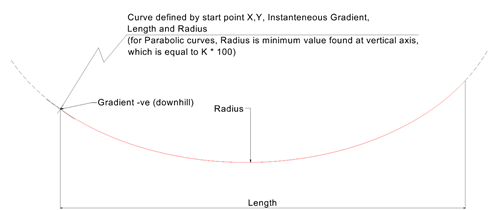Semantic definitions at the entity
Entity definition
The vertical parabolic segment is defined as a parabola using the inherited attributes from IfcAlignment2DVerticalSegment and the following additional curve parameters ParabolaConstant as the minimum radius of the parabolic arc at its apex, and IsConvex to indicate the whether the parabolic arc defined a sag or a crest.
The parabolic arc is described by (see figure 1):
- R = signed ParabolaConstant, if IsConvex = true, then +R, if IsConvex = false, then -R as length measure
- s0 = StartDistAlong as length measure
- z0 = StartHeight as length measure
- g0 = StartGradient as ratio measure
The following equations are used for any point along the parabola:
- at any point s1 along the HorizontalLength
- the gradient g1 = (s1-s0) / R + g0
- the height z1 = (s1-s0) * (g1+g0)/2 + z0
 |
|
Legend: red: the parabolic curve with start point and calculated end point used as an vertical alignment yellow: the underlying unbounded parabola definition blue: the minimum circle defined by the parabola constant agreeing to the "is convex" fag, the constant, and the start gradient |
Figure 214 — Alignment vertical segment parabola convex |
 | start point provided by StartDistAlong and StartHeight instanteneous gradient provided by StartGradient, and length provided by HorizontalLength |
Figure 215 — Alignment vertical parabolic arc segment convex |
 | start point provided by StartDistAlong and StartHeight instanteneous gradient provided by StartGradient, and length provided by HorizontalLength |
Figure 215 — Alignment vertical parabolic arc segment concave |
Attribute definitions
| # | Attribute | Type | Cardinality | Description | B |
|---|---|---|---|---|---|
| 8 | ParabolaConstant | IfcPositiveLengthMeasure | [1:1] | Parabola constant (determining the “steepness” of the parabola). The parabola constant is provided by the “minimum parabola radius”, the true radius of a parabola at its vertical axis (the zero-gradient point of the parabola). The minimum radius is twice the focal length of the parabola (the distance between the focal point and the vertex). | X |
| 9 | IsConvex | IfcBoolean | [1:1] |
Orientation of the parabolic arc, convex (Boolean=”true”) means that the minimum radius is the distance between the vertex and the center point along the positive direction of the vertical axis, and concave (Boolean=”false”) means along the negative direction of the vertical axis.
NOTE&bsp; Convex normally stands for a sag or valley and concave for a crest or hill | X |

 EXPRESS-G diagram
EXPRESS-G diagram Link to this page
Link to this page